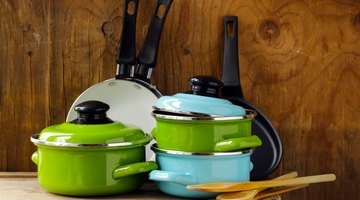Club Aluminum Pots & Pans Information
Club Aluminum Cookware is retro today, but when introduced nearly 100 years ago, it was cutting edge. It also brought a new way of making and selling the aluminum pots and pans. Cooks also liked aluminum's similarity to silver. Cast aluminum featured excellent heat conductivity, and unlike cast iron, could come with wooden handles. About half of all cookware is still made with aluminum. History At first, you couldn’t buy Club Aluminum in shops.

Club Aluminum Cookware is retro today, but when introduced nearly 100 years ago, it was cutting edge. It also brought a new way of making and selling the aluminum pots and pans. Cooks also liked aluminum's similarity to silver. Cast aluminum featured excellent heat conductivity, and unlike cast iron, could come with wooden handles. About half of all cookware is still made with aluminum.
History
At first, you couldn’t buy Club Aluminum in shops. Club Aluminum began before Tupperware, Avon and Pampered Chef parties. Club Aluminum started in Chicago as the Club Aluminum Utensil Company in 1923.
A 1925 Club Aluminum cookbook informed cooks of the company's new technology: “The first entire kitchen equipment of processed hardened aluminum, scientifically constructed with tight-fitting covers." Club Aluminum was also “scientifically constructed to last a lifetime,” according to the book.
Trademark tight-fitting covers helped seal in moisture, which meant there was no need to add water. This introduced a new style of cooking in the home. Club Aluminum touted this cooking style for its health benefits because essential nutrients didn't escape through steam. The company sold the cookware on the party plan by selling it “directly to home managers through health lectures,” according to the Club Aluminum cookbook.
The cookware parties were most common from 1923, when Club Aluminum began, through 1933, when the Depression made such parties too expensive. The company declared bankruptcy that year and emerged with a new name, Club Products Standard International. The company’s new leader, Herbert Taylor, tested his new business philosophy on the company. That philosophy, the Four Way Test, is still part of Rotary Clubs worldwide today.
The company sold Club Aluminum products through the end of the 20th century, although its heyday was from the late 1930s through the 1960s. Not surprisingly, Club Aluminum pots have the colorful, rounded mid-century modern look of that era. Today, Mirro owns Club Aluminum.
Where to Buy
You can find Club Aluminum pots and pans on eBay, Etsy, Pinterest, in antique shops and through online retailers who specialize in vintage kitchen products. The trademark Club Aluminum stovetop rings, found in a raised pattern on the bottoms of its pots and pans, let you know you have a genuine Club Aluminum product.
Wares
Club Aluminum cookware includes large Dutch ovens with handles, smaller Dutch ovens, frying pans, saute pans, coffee percolators, water pitchers, roasting pans with lids and accompanying servers, doughnut molds and fluted cake pans. Colors include aqua, turquoise, teal, pink, red, yellow, brown and silver. If you collect mid-century modern ware, you may like Club Aluminum's avocado green and harvest gold colors.
Club Aluminum also made an unusual waffle iron with a flat bottom. It had a plunger rod attached to the upper cooking grid. This grid assembly is able to slide upward inside the domed lid, allowing for the batter to expand without dripping out the sides. But it was difficult to decide when the waffle was ready. You can read about this unique waffle iron in the book “Antique Electric Waffle Irons 1900-1960: A History of the Appliance Industry in 20th Century America.”
Club Aluminum also comes in a Hammercraft aluminum. A hammered finish had a dimpled look to it. This finish helped make the dish look more upscale. The hammered look comes from a mold, and was not handmade as it would have been on more expensive brass, copper and tin pieces.
Prices
Club Aluminum pieces sell for as little as $10, although larger pots with lids can sell for $50 to $100. Sets and some of the more rare pieces will sell for over $100.
References
Writer Bio
Karen Gardner is a freelance writer and editor based in Maryland. She has more than 20 years of experience writing and editing health, home and gardening stories.
More Articles



